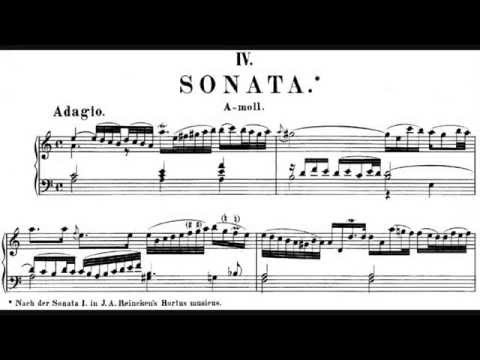– Composer: Johann Sebastian Bach (31 March 1685 — 28 July 1750)
– Performer: Grigori Sokolov
– Year of recording: 2003 (Live in Schwentzingen, Germany
Bach’s adaptation of the Sonata No.1 for strings and continuo from “Hortus Musicus” by Johann Adam Reincken, written circa 1705.
00:00 – I. Adagio
02:19 – II. Fuga
05:52 – III. Adagio
06:39 – IV. Presto
07:12 – V. Allemande
10:59 – VI.Courante
13:49 – VII. Sarabande
17:05 – VIII. Gigue
Curious about all forms of music, Bach did not merely seek to acquaint himself with them. He wanted to understand, to penetrate the thought behind them, making copies, and even transcriptions of Vivaldi, Couperin, Handel, Telemann, Frescobaldi, Pergolesi and many others; there are numerous examples, all more or less well-known.
Less well-known is the adaptation he made of a work by Reincken. While still a young man studying at the Lüneburg Gymnasium, “[Bach] would sometimes go to Hamburg to listen to the then celebrated organist, Johann Adam Reincken, in the church of Saint Catherine” if we are to believe his second son, Carl Philipp Emanuel. The music of the Great Man of Hamburg was thus an early focus for the young musician’s admiration, and it was no doubt during this period that he came to know Reincken’s “Hortus musicus” (Musical Garden), published in 1687. This was a group of six sonatas in four parts, for two violins, viola and basso continuo.
Bach appreciated them sufficiently to have made copies and then transcriptions for solo harpsichord of two of them and a fugue of a third. But as was his wont, in reducing the instrumentation to a single harpsichord, he also enriched his model, adding here a new voice, there new developments, and a level of overall ornamentation lacking in the original: re-creations in the purest sense of the word.
This attitude was characteristic of him, as can be seen in the adaptation of the first sonata in the collection, making it his A minor sonata (BWV 965) with its considerably amplified fugue and gigue, compensating with density what the work lost in diversity of colour.
At any rate, this is a fantastic performance by Sokolov, who always seems to be able to communicate all the many layers in Bach’s work.




